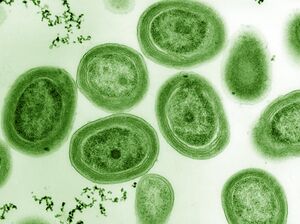Prochlorococcus and Climate Change: Difference between revisions
| Line 24: | Line 24: | ||
==What are <i>Prochlorococcus</i>?== | ==What are <i>Prochlorococcus</i>?== | ||
Prochlorococcus is a gram negative, coccus bacteria species in the genus cyanobacteria. Prochlorococcus is an aquatic autotroph, found throughout the planet's oceans (Biller et al. 2015). Earth’s oxygen-rich atmosphere is the result of Cyanobacteria and their mass amounts of photosynthesis. Specifically, Prochlorococcus is one of the most abundant autotrophic bacteria in the planet’s oceans (Biller et al. 2015). Prochlorococcus can number up to 70,000 cells in a milliliter of ocean water (Campbell et al. 1998). These vast quantities produce a significant percentage of Earth’s entire photosynthetic output and up to 79 percent of the North Atlantic Ocean’s entire primary production (Biller et al. 2015) (Li 1994). As a result of their large photosynthetic potential, they are a key organism in the fight against climate change and the sequestration of atmospheric carbon. Prochlorococcus uptake more carbon dioxide to undergo photosynthesis than they use up in respiration, creating a stock of carbon inside each organism (Li 1994). When Prochlorococcus dies, it sinks to the bottom of the ocean and is buried, eventually forming oil in what is known as the ocean biological pump (Resplandy et al. 2019). In this way, Prochlorococcus serve as a sink for atmospheric carbon and have an impact on climate change. | |||
==The Effect of Climate Change on <i>Prochlorococcus</i>== | ==The Effect of Climate Change on <i>Prochlorococcus</i>== | ||
Revision as of 18:10, 15 April 2023
By Zachary Aronson-Paxton
At right is a sample image insertion. It works for any image uploaded anywhere to MicrobeWiki.
The insertion code consists of:
Double brackets: [[
Filename: PHIL_1181_lores.jpg
Thumbnail status: |thumb|
Pixel size: |300px|
Placement on page: |right|
Legend/credit: Electron micrograph of the Ebola Zaire virus. This was the first photo ever taken of the virus, on 10/13/1976. By Dr. F.A. Murphy, now at U.C. Davis, then at the CDC. Every image requires a link to the source.
Closed double brackets: ]]
Other examples:
Bold
Italic
Subscript: H2O
Superscript: Fe3+
Sample citations: [1]
[2]
A citation code consists of a hyperlinked reference within "ref" begin and end codes.
To repeat the citation for other statements, the reference needs to have a names: "<ref name=aa>"
The repeated citation works like this, with a forward slash.[1]
What are Prochlorococcus?
Prochlorococcus is a gram negative, coccus bacteria species in the genus cyanobacteria. Prochlorococcus is an aquatic autotroph, found throughout the planet's oceans (Biller et al. 2015). Earth’s oxygen-rich atmosphere is the result of Cyanobacteria and their mass amounts of photosynthesis. Specifically, Prochlorococcus is one of the most abundant autotrophic bacteria in the planet’s oceans (Biller et al. 2015). Prochlorococcus can number up to 70,000 cells in a milliliter of ocean water (Campbell et al. 1998). These vast quantities produce a significant percentage of Earth’s entire photosynthetic output and up to 79 percent of the North Atlantic Ocean’s entire primary production (Biller et al. 2015) (Li 1994). As a result of their large photosynthetic potential, they are a key organism in the fight against climate change and the sequestration of atmospheric carbon. Prochlorococcus uptake more carbon dioxide to undergo photosynthesis than they use up in respiration, creating a stock of carbon inside each organism (Li 1994). When Prochlorococcus dies, it sinks to the bottom of the ocean and is buried, eventually forming oil in what is known as the ocean biological pump (Resplandy et al. 2019). In this way, Prochlorococcus serve as a sink for atmospheric carbon and have an impact on climate change.
The Effect of Climate Change on Prochlorococcus
How does climate change influence the number and efficacy of Prochlorococcus microbes throughout the planet's oceans?
Include some current research, with at least one figure showing data.
Every point of information REQUIRES CITATION using the citation tool shown above.
Prochlororcoccus’ Impact on the Oceans
How does Prochlorococcus’ large scale photosynthetic processes affect ocean ecosystems?
Include some current research, with at least one figure showing data.
Prochlororcoccus’ Effect on the Changing Planet
Does Prochlorococcus have a direct impact on the planet’s atmosphere and the process of climate change?
Include some current research, with at least one figure showing data.
Conclusion
References
Authored for BIOL 238 Microbiology, taught by Joan Slonczewski, 2023, Kenyon College

